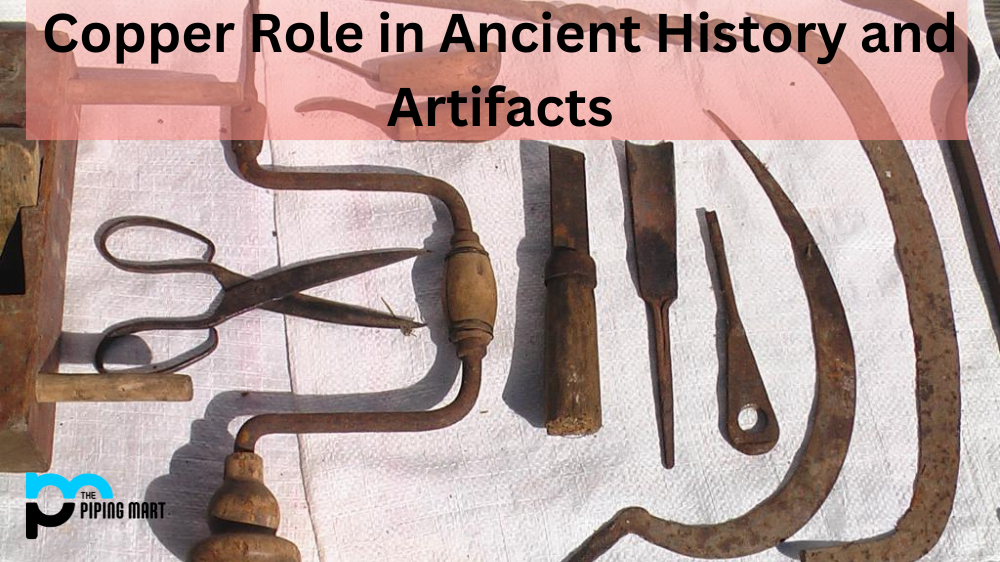Copper is one of the oldest metals known to humankind, dating back to the Neolithic period around 8700 BC. It has been used for centuries by ancient
civilizations to make tools and artifacts, from weaponry and jewelry to intricate sculptures. This article will discuss the role of copper in ancient history and its use as a medium for creating beautiful artifacts.
Copper Use in Ancient Times
In ancient times, copper was a highly sought-after material used to make tools and weapons due to its malleability, durability, and low melting point. The Egyptians were among the earliest cultures to develop metallurgy, using copper alloys such as bronze (copper + tin) and brass (copper + zinc) for tools, weapons, jewelry, ornaments, and statues. In Mesopotamia (modern-day Iraq), around 3000 BC, copper was used for coins and swords and helmets made of bronze. In India during this same time period, copper became popular for making vessels such as bowls and vases due to its non-corrosive properties.
The Romans also developed their own metallurgy techniques using copper alloys with lead or iron, which they used to make various items like keys or coins. During the Iron Age (1200 BC – 500 AD), people began using iron instead of copper because it was cheaper; however, until then, copper remained an important part of many cultures’ daily lives.
- Copper has been used by humans for over 10,000 years.
- Copper is a soft metal that is easily worked and molded.
- Copper is an excellent conductor of heat and electricity.
- Copper is resistant to corrosion and is not affected by most acids.
- Copper is found in nature in its pure form, as well as in compounds such as copper sulfate and copper carbonate.
- Uses for copper include jewelry, coins, plumbing, electrical wiring, and cookware.
Copper Artifacts throughout History
The use of copper in museums today ranges from coins to sculptures that have existed since antiquity. In fact, some of the most iconic pieces from Ancient Egypt are made entirely out of copper or bronze alloy—such as Tutankhamun’s death mask or Ramses II’s bronze statue found in Luxor Temple—demonstrating how important this metal was at that time. Other famous artifacts made out of copper include the Statue of Liberty in New York City, which has a skeleton composed entirely of steel covered with a thin layer of pure copper for protection against corrosion.
Early Uses of Copper
Copper has been used by humans for thousands of years and was one of the first metals to be exploited by our ancestors. Copper was first used in the Middle East around 8000 BCE, where it was used to make tools and weapons. By 4000 BCE, copper was being used in China and other parts of Asia.
The Bronze Age
The Bronze Age is a period in human history that gets its name from the widespread use of bronze, an alloy of copper and tin. The Bronze Age began in the Middle East around 3000 BCE and spread to other parts of the world over the next few thousand years. During this time, bronze was used to make a variety of objects, including tools, weapons, armor, and jewelry.
Copper in the Americas
Copper also played an important role in the cultures of pre-Columbian America. Copper objects have been found in a number of archaeological sites in North and South America, dating back to 2000 BCE. The most famous copper artifact from this period is the “Sun Stone”, a large sculpture that was found in Mexico City.
Modern Uses of Copper
Today, copper is still widely used in a variety of applications. It is commonly used in electrical wiring and plumbing, as it is an excellent conductor of electricity and heat. Copper is also often used in coins and jewelry, as it has a beautiful reddish color when polished.
Health Effects of Copper
While copper is an essential nutrient for human health, too much copper can be harmful. Exposure to high levels of copper can cause nausea, vomiting, diarrhea, and liver damage. However, these effects are typically only seen at very high levels of exposure that are not typically encountered by most people
Conclusion:
Copper is one of humanity’s oldest materials that has been used by many different cultures throughout history for crafting tools, weapons, jewelry, and other objects such as statues or vessels due to its malleability and affordability compared with other metals like gold or silver. Its use can be seen today in monuments like The Statue of Liberty, which showcases how much we value this versatile metal even today! Copper remains an integral part not only our history but also our present-day culture thanks to its timeless beauty and functionality!
Meet Heer, a dynamic and driven writer learning tricks of her trade in the metal industry. With a background in Digital Marketing, Heer brings a unique perspective to her writing, sharing valuable insights. Apart from blogging she like reading and hiking.




